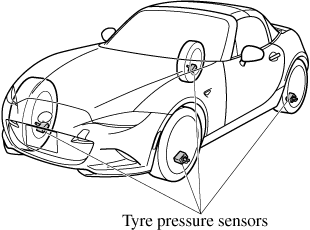

Tyre Pressure Monitoring System


Tyre Pressure Monitoring System (Vehicle with Run-flat Tyres) (Some Models)
The Tyre Pressure Monitoring System (TPMS) monitors the pressure for each tyre.
If tyre pressure is too low in one or more tyres, the system will inform the driver via the warning light in the instrument cluster and by the warning beep sound.
Refer to Warning Indication/Warning Lights (Search).
Refer to Tyre Inflation Pressure Warning Beep (Search).
The tyre pressure sensors installed on each wheel send tyre pressure data by radio signal to the receiver unit in the vehicle.

When the ambient temperature is low due to seasonal changes, tyre temperatures are also lower. When the tyre temperature decreases, the air pressure decreases as well. The TPMS warning light may illuminate more frequently. Visually inspect the tyres daily before driving, and check tyre pressures monthly with a tyre pressure gauge. When checking tyre pressures, use of a digital tyre pressure gauge is recommended.


TPMS does not alleviate your need to check the pressure and condition of all four tyres regularly.
-
Each tyre, including the spare (if provided), should be checked monthly when cold and inflated to the inflation pressure recommended by the vehicle manufacturer on the vehicle placard or tyre inflation pressure label. (If your vehicle has tyres of a different size than the size indicated on the vehicle placard or tyre inflation pressure label, you should determine the proper tyre inflation pressure for those tyres.)
As an added safety feature, your vehicle has been equipped with a tyre pressure monitoring system (TPMS) that illuminates a low tyre pressure telltale when one or more of your tyres is significantly under-inflated. Accordingly, when the low tyre pressure telltale illuminates, you should stop and check your tyres as soon as possible, and inflate them to the proper pressure. Driving on a significantly under-inflated tyre causes the tyre to overheat and can lead to tyre failure. Under-inflation also reduces fuel efficiency and tyre tread life, and may affect the vehicle's handling and stopping ability.
Please note that the TPMS is not a substitute for proper tyre maintenance, and it is the driver's responsibility to maintain correct tyre pressure, even if under-inflation has not reached the level to trigger illumination of the TPMS low tyre pressure telltale.
Your vehicle has also been equipped with a TPMS malfunction indicator to indicate when the system is not operating properly.
The TPMS malfunction indicator is combined with the low tyre pressure telltale. When the system detects a malfunction, the telltale will flash for approximately one minute and then remain continuously illuminated. This sequence will continue upon subsequent vehicle start-ups as long as the malfunction exists. When the malfunction indicator is illuminated, the system may not be able to detect or signal low tyre pressure as intended. TPMS malfunctions may occur for a variety of reasons, including the installation of replacement or alternate tyres or wheels on the vehicle that prevent the TPMS from functioning properly. Always check the TPMS malfunction telltale after replacing one or more tyres or wheels on your vehicle to ensure that the replacement or alternate tyres and wheels allow the TPMS to continue to function properly.
-
To avoid false readings, the system samples for a little while before indicating a problem. As a result it will not instantaneously register a rapid tyre deflation or blow out.




 Read this first
Read this first

















